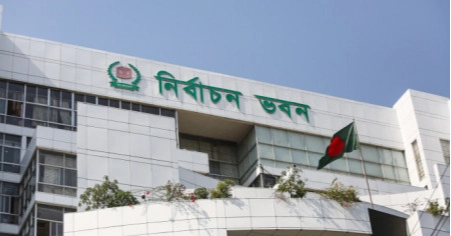Ahead of the 13th National Parliamentary elections, residents of respective districts have demanded that the Bagerhat-4 constituency be retained, the number of seats in the three hill districts of Chittagong Hill Tracts be increased to eight, and one additional seat each be allocated to Satkhira (increasing from four to five), Barguna (from two to three), and Pirojpur (from three to four).
These demands were raised during the second day of hearings at the Election Building in Agargaon on Monday. The hearing, chaired by Senior Secretary Akhtar Ahmed, was attended by Chief Election Commissioner (CEC) AMM Nasir Uddin, four election commissioners, and senior officials of the Election Commission.
During the hearing at the Election Building auditorium, lawyers representing the petitioners or objectors stood at designated spots to present their arguments. Following a clash during Sunday’s hearing for Brahmanbaria-2 and 3 constituencies, separate dais were arranged for opposing sides from that afternoon onward.
On Monday, hearings were held for claims and objections regarding 20 constituencies in the Khulna, Barisal, and Chittagong divisions. The hearings covered Satkhira-3 and 4; Jessore-3 and 6; Bagerhat-1, 2, and 3; Jhalakathi-1; Barguna-1 and 2; Pirojpur-1, 2, and 3; Chittagong-3, 5, 8, and 10; and the constituencies of Khagrachhari, Rangamati, and Bandarban.
In its effort to balance voter numbers in constituency delimitation, the Election Commission has proposed increasing the number of seats in Gazipur from five to six and reducing the seats in Bagerhat from four to three. Previously, Bagerhat’s four constituencies were: Bagerhat-1 (Mollarhat-Fakirhat-Chitalmari); Bagerhat-2 (Sadar and Kachua); Bagerhat-3 (Rampal and Mongla); and Bagerhat-4 (Morelganj and Sharankhola).
The draft proposal retains Bagerhat-1 as before, while Bagerhat-2 would comprise Bagerhat Sadar, Kachua, and Rampal, and Bagerhat-3 would include Mongla, Morelganj, and Sharankhola.
After the hearing, Advocate Wahiduzzaman Dipu, a representative for Bagerhat-3, told journalists, “Bagerhat has had four constituencies since the country’s independence. Suddenly, the EC tells us there will no longer be four seats. The people of Bagerhat do not accept the removal of one seat. This is illogical, contrary to law, and unrealistic. The EC’s decision goes against public interest.” He demanded that all four constituencies be retained as before.
Another representative for the same constituency, Barrister Md Zakir Hossain, said, “By reducing one seat in Bagerhat, the EC has deprived the people of Bagerhat of their rights. The EC is acting against the spirit of the July uprising. Do not push us toward movement and struggle or toward the courts. Do not let the February election be disrupted in any way.”
BNP leader Kazi Moniruzzaman Monir said, “Bagerhat does not need four seats – it needs five.”
Meanwhile, Molla Rahmatullah, joint chief organiser of the NCP, who attended as a representative for Bagerhat-3, alleged, “We could not present our arguments yesterday (Sunday) regarding the parliamentary constituency. Today, again, we were unable to present our case. It seems the Election Commission is working only for one party. The decision they have made based on voter numbers does not seem logical to us.”
Iqbal Hossain Forqan has requested changes to the boundaries of the two constituencies in Jhalakathi. His lawyer, Dr Md Shahjahan, argued at the EC hearing, “There is a huge disparity in the number of voters between Jhalakathi-1 and Jhalakathi-2. Currently, 62% of the district’s voters are in Jhalakathi-2, and 38% are in Jhalakathi-1.”
He appealed to transfer four unions – Ranapasha, Subidpur, Kushangal, and Mollarhat – from Jhalakathi-2 to Jhalakathi-1 to balance voter numbers.
Chittagong Hill Tracts’ civil society has demanded an increase in the number of constituencies in the region to eight. In a written statement to journalists after the EC hearing, they stated: “The three hill districts – Khagrachhari, Rangamati, and Bandarban – cover an area of 13,295 square kilometers with a population of 1,842,815 people. There are only three parliamentary constituencies for these three hill districts. The development activities in the promising Chittagong Hill Tracts and the improvement of the living standards of the marginalised communities here have stalled due to the failure to increase the number of parliamentary seats as needed. It is exceedingly difficult for three members of parliament to represent the people of 26 upazilas.”
The written demand was signed by Engineer Shahadat Faraji Sakib, founding president of the Chittagong Hill Tracts Students’ Council, and Engineer Nazmul Haque. They were accompanied by representatives of civil society, including Paishikhai Marma and Ibrahim Khalil Chowdhury, founding senior vice-president of the Chittagong Hill Tracts Council.
They proposed the following constituencies: Khagrachhari-1 comprising Ramgarh, Manikchhari, Lakshmichhari, and Guimara; Khagrachhari-2 consisting of Matiranga, Mahalchhari, and Panchhari; Khagrachhari-3 including Khagrachhari Sadar and Dighinala; Rangamati-1 made up of Baghaichhari, Langadu, and Barkal; Rangamati-2 covering Rangamati Sadar, Naniarchar, and Kaptai; Rangamati-3 containing Jurachhari, Bilaichhari, Rajasthali, and Kaptai; Bandarban-1 incorporating Bandarban Sadar, Ruma, Thanchi, and Rowangchhari; and Bandarban-2 encompassing Lama, Alikadam, and Naikhongchhari.


